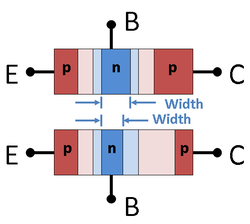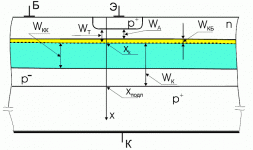Re: Re: @10mA and @2mA
Not really; Cob is defined by the collector side (lightly doped) not by the base region. The big conflict is between Beta and rbb. The solution is very high base doping and a very thin metalurgical base, with extremely well controled impurity profiles. That's why all these Sanyo devices are using ion implanted base regions. By diffusion only you can get something like the MJE15030. Low rbb (also very good for secondary breakdown) and low beta (under 100).
I'm suspecting Hitachi is using the same type of base ion implanted process, otherwise I can't imagine how to get a beta of 400 and rbb of a few ohms.
Terry Demol said:
The 3601 is quite an intriguing device, low Rbb and ultra low Cob
would appear to me to be conflicting attributes - am I right here?
Not really; Cob is defined by the collector side (lightly doped) not by the base region. The big conflict is between Beta and rbb. The solution is very high base doping and a very thin metalurgical base, with extremely well controled impurity profiles. That's why all these Sanyo devices are using ion implanted base regions. By diffusion only you can get something like the MJE15030. Low rbb (also very good for secondary breakdown) and low beta (under 100).
I'm suspecting Hitachi is using the same type of base ion implanted process, otherwise I can't imagine how to get a beta of 400 and rbb of a few ohms.
hitsware said:
...like name of Kirk to a kink on a curvetracer? 😀
Edit: Syn08, what about silicon carbide?
Wavebourn said:
Edit: Syn08, what about silicon carbide?
Long story short: not anytime soon for audio purposes.
syn08 said:
Long story short: not anytime soon for audio purposes.
Let's wait for a military surplus. 😎
It is the first material ever used for radio!
Re: Re: Re: @10mA and @2mA
Many thanks Syn.
T
syn08 said:
Not really; Cob is defined by the collector side (lightly doped) not by the base region. The big conflict is between Beta and rbb. The solution is very high base doping and a very thin metalurgical base, with extremely well controled impurity profiles. That's why all these Sanyo devices are using ion implanted base regions. By diffusion only you can get something like the MJE15030. Low rbb (also very good for secondary breakdown) and low beta (under 100).
I'm suspecting Hitachi is using the same type of base ion implanted process, otherwise I can't imagine how to get a beta of 400 and rbb of a few ohms.
Many thanks Syn.
T
syn08,
2SB737 and 2SB821
rbb = 2 Ohms, En = 0.55nV @ 10Hz/ Ic = 10mA, 0.4nV @ 1kHz, hFE = 120-560.
2SC3329/2SA1316
rbb = 2 Ohms, En = 0.6nV, Cob 6.2pF, hFE = 200-700
2SC2545-47/2SA1083-85
En = 0.5nV @ 10mA and 1kHz, Cob 3pF,. hFE = 250-1200, rbb must be very low.
Instead of messing around (with unsuitable candidates), I would go for 2SC2545, since Hitachi devices have a strong propensity to sound good (not always apparent from data sheets).
Edmond,
right?
😀
Not big, but rather small:The big conflict is between Beta and rbb.
2SB737 and 2SB821
rbb = 2 Ohms, En = 0.55nV @ 10Hz/ Ic = 10mA, 0.4nV @ 1kHz, hFE = 120-560.
2SC3329/2SA1316
rbb = 2 Ohms, En = 0.6nV, Cob 6.2pF, hFE = 200-700
2SC2545-47/2SA1083-85
En = 0.5nV @ 10mA and 1kHz, Cob 3pF,. hFE = 250-1200, rbb must be very low.
Instead of messing around (with unsuitable candidates), I would go for 2SC2545, since Hitachi devices have a strong propensity to sound good (not always apparent from data sheets).
Edmond,
right?
😀
beta vs rbb
 Exceptio probat regulam ....
Exceptio probat regulam ....
Lumba Ogir said:[snip]
Edmond,
right?
😀
 Exceptio probat regulam ....
Exceptio probat regulam ....Toshiba 2SA970 / 2SC2240
are good audio transistors
- affordable
- easy to find most shops
- can take 120 Volt across c-e
- fairly low noise
- used in many classical audio amplifier designs
- one matched pair makes a good amp input
There are better, exotic, hard-to-find devices.
But for bipolar transistors we come a good way on, when buying
a bunch of 100 pcs. Toshiba wellknown 2SA970 / 2SC2240
Regars
lineup
are good audio transistors
- affordable
- easy to find most shops
- can take 120 Volt across c-e
- fairly low noise
- used in many classical audio amplifier designs
- one matched pair makes a good amp input
There are better, exotic, hard-to-find devices.
But for bipolar transistors we come a good way on, when buying
a bunch of 100 pcs. Toshiba wellknown 2SA970 / 2SC2240
Regars
lineup
Lumba Ogir said:syn08,
Not big, but rather small:
Add "conflict" to the above list. Here, it means it's difficult to manufacture devices with both high beta and low rbb, rather impossible with standard diffusion processes.
Syn
What disturbed me most with your measurements was not the noise although Im a bit surprised how high it is but the low hfe. Ive used those sanyo devices for over 15 years, never have I come across such low figures except once and those were the first fakes of those trannies Ive come across. Only the markings were slightly lighter in appearance and they were from same usual supplier. Because I was suspicious of the low hfe I sent a sample to a contact at sanyo, and he later confirmed that the parts were remarked to mimick their components. The supplier was surprised but replaced them. All my sanyo I ve have used measured more than double the figures you state and some by a large margin. I have to wonder irrespective of the reputation of the supplier, happens to the best of them including mine.
For low noise applications I employ 2sa1455k and compliment, what do you think of these ??
Like Terry I also find that low noise trannies have higher cob figures but this is understandable because they also have higher current capability, look at the 2sa1085, so there seems to be some conflict. This could easily be verified if you have a 2sa1406 to measure.
Having just extreme low noise is not the highway to audio nirvana, maybe just more important in phono applications.
What disturbed me most with your measurements was not the noise although Im a bit surprised how high it is but the low hfe. Ive used those sanyo devices for over 15 years, never have I come across such low figures except once and those were the first fakes of those trannies Ive come across. Only the markings were slightly lighter in appearance and they were from same usual supplier. Because I was suspicious of the low hfe I sent a sample to a contact at sanyo, and he later confirmed that the parts were remarked to mimick their components. The supplier was surprised but replaced them. All my sanyo I ve have used measured more than double the figures you state and some by a large margin. I have to wonder irrespective of the reputation of the supplier, happens to the best of them including mine.
For low noise applications I employ 2sa1455k and compliment, what do you think of these ??
Like Terry I also find that low noise trannies have higher cob figures but this is understandable because they also have higher current capability, look at the 2sa1085, so there seems to be some conflict. This could easily be verified if you have a 2sa1406 to measure.
Having just extreme low noise is not the highway to audio nirvana, maybe just more important in phono applications.
homemodder said:Syn
What disturbed me most with your measurements was not the noise although Im a bit surprised how high it is but the low hfe. For low noise applications I employ 2sa1455k and compliment, what do you think of these ??
Like Terry I also find that low noise trannies have higher cob figures but this is understandable because they also have higher current capability, look at the 2sa1085, so there seems to be some conflict. This could easily be verified if you have a 2sa1406 to measure.
My 2SC2362 stash is F grade; a beta of 200 is normal (160-320 according to the datasheet). I can't imagine somebody took care to remark devices according to the Sanyo datasheet grades.
I haven't measured any pnp's, I need another test jig.
I don't think there is any first order dependency on the path high current->large area->largeCob->low noise. Otherwise said, I don't see any reason why a low noise device should necessary be high current capable. There is a noise component that is proportional to 1/gm, but this is not a good reason to go over 10mA. At high currents, the flicker noise dominates, because the 1/f corner frequency increases accordingly (see the data for 10mA and 2mA).
My fake trannies are marked 2sa1016 kg6l. and 2sc2362 g 2g. , kept a couple for reference.
Since you clued up with the manufacturing process what would the result be from the same tranny but with different hfe, would the rbb be the same irrespective of the hfe?
Could you perhaps point me to a good reference or book on transistor physics and manufacturing.
Since you clued up with the manufacturing process what would the result be from the same tranny but with different hfe, would the rbb be the same irrespective of the hfe?
Could you perhaps point me to a good reference or book on transistor physics and manufacturing.
- Status
- Not open for further replies.
- Home
- Amplifiers
- Solid State
- Addressing John Curl's concerns on low noise designs
![url]](/community/proxy.php?image=http%3A%2F%2F%5Burl%5Dhttp%3A%2F%2Fupload.wikimedia.org%2Fwikipedia%2Fcommons%2Fthumb%2F3%2F33%2FPnp_Base_Narrowing.png%2F250px-Pnp_Base_Narrowing.png%5B%2Furl%5D&hash=9434d9c3fb13a8896fd8a30d59f0ad82)

